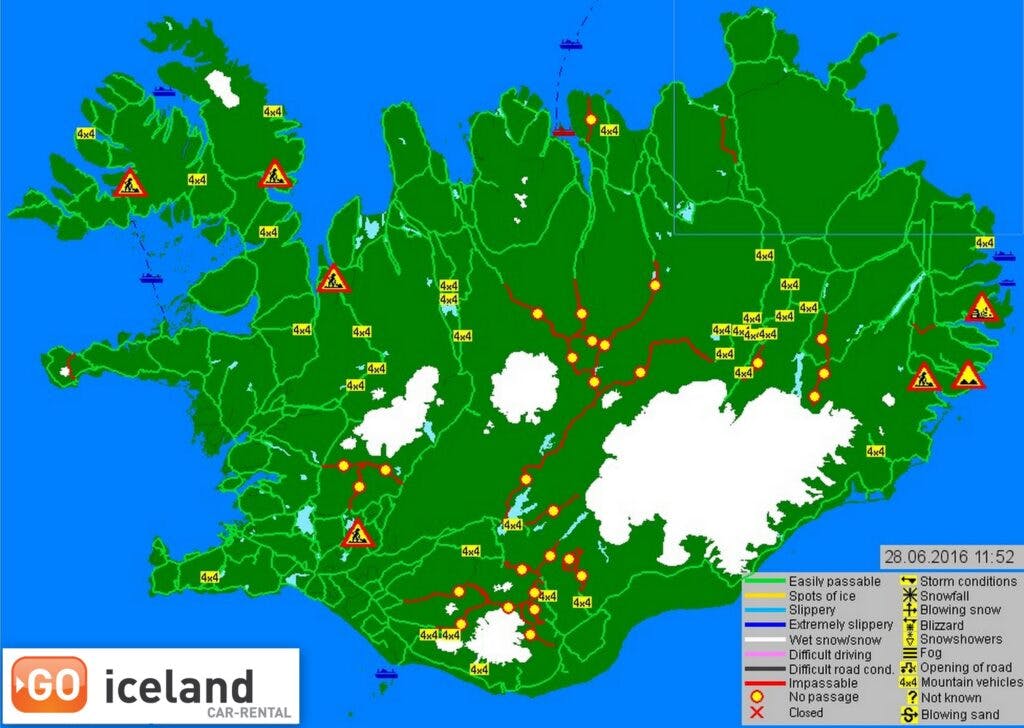May 6, 2025
Guide to Driving Iceland’s F-Roads
Moving into summer, many visitors to Iceland find themselves wanting to explore the rugged F-roads in the stunning Highlands of Iceland. For visitors to Iceland, it can be hard to get your head around these roads only open in summer - weather-dependent, of course. You’ll need to know the right vehicle, the right times, and the driving techniques to adopt to make the most of these stunning hidden gems.
What are F-Roads in Iceland?
If you’ve never heard of F-roads, don’t panic. These are mountain roads that carve up the Highlands in the country's center. These road names are often marked with an “F”, hence they are called “F-roads”.
Tourists less frequently visit this remote area compared to the easily accessible edges of the country. As a result, the roads in these mountainous areas are often not paved so it can be more difficult to traverse for inexperienced drivers.
Places to stop can be rarer, so you’ll spot far fewer gas stations, shops, and accommodation options.
Map of Iceland’s F-Roads

Driving Conditions on the F-Roads
When driving on F-roads expect the unexpected like big potholes, rocks, very loose gravel, sheep, tight corners, soft shoulders, roads broken by running water, and oncoming traffic.
Many roads require crossing a river pass but bear in mind that typical insurance will not cover possible damages caused while fording a river, so only crossing at the lowest river levels or avoiding this altogether is recommended.
While speed limits can be up to 80 km/h (50 m/h) on gravel roads, you may be limited to lower speeds by the rough terrain.
The Icelandic Road and Coastal Administration updates its page continuously to provide the most up-to-date road condition information. It’s never recommended to head off on F-roads in Iceland without checking forecasts or having a plan for where you will be going.
When are F-Roads Open?
The general rule for F-roads in Iceland is that they are only open in summer, usually late May and early June, with exact dates being released every year. The deeper into the center of the Highlands the road is located, typically the later the road will be open.Authorities will monitor weather conditions in the Highlands, which can be incredibly changeable and dramatic, to ascertain opening and closing dates. Check road opening updates from the authorities, which will provide information when the Highland roads are open.
Read more: Rental car damage assessmentReady to hit the road? Secure your car today
Can all Cars be Used on F-Roads?
Due to the unpaved nature of F-roads in Iceland, only cars that can tackle the rough terrain are permitted in the Highlands. Put simply, if you don’t hire a 4x4 (4WD) vehicle, it is illegal to enter any roads marked with an F, as well as Kaldidalur Valley (Road 550), Kjölur (Road 35), and Jökulhálsleið (Road 570).
Our rental fleet includes a range of 4x4 vehicles suitable to take on the rugged F-road of Iceland. Browse today and find the right size and availability for you.

Staying Safe on F-Roads
There are a few ways you can increase your safety while on a trip to the Highlands. In general, use common sense while you are driving anywhere in Iceland and take your time. When you want to take pictures (which is to be expected), park your rental car where it does not pose any danger to others, and be aware of passing cars. Decide where you want to go and what you want to see off the beaten path, then make sure the roads are passable before setting off.
If you ever feel uncomfortable driving on a particular road, turn back. There are others to choose from. Being unsure, stressed, tired, or even continuing a journey in adverse weather can cause an accident - you don’t want to ruin an otherwise wonderful vacation!
Safe Travel App
The first thing you should do is install the Safe Travel App we have here in Iceland. It fulfills two functions. The first function is to be used if you find yourself in an emergency - you simply hit the red button. A text is then sent to the local emergency services. Remember that even if it seems you are out of range from any mobile network, the phone will likely still be able to send the alert.

The second function is to use the app to check in with authorities. While traveling around Iceland, you can always hit the green button now and again. This sends a message to notify authorities of your rough location so that if an emergency does happen or if you are marked as missing, your previous positions can point to your location. Only the last five locations are stored by relevant authorities - and don’t think you are disturbing anyone by checking in! It will only be reviewed if necessary.
Plan Your Itinerary
This may not appeal to more spontaneous travelers, but this is crucial for your safety. Before embarking on your adventure, it’s important to make a plan. Decide where you are going, what roads you will be driving on, and how long you expect to be on the road. When you have finalized your itinerary, let someone know - it’s good if this person is based in Iceland, your hotel receptionist for example, or you can send your Travel Plan to Safe Travel.
Personal Location Beacon (PLB)
The people at Safe Travel have added another service to help you out in case of an emergency. Tourists can now rent Personal Location Beacon (PLB). This device is a brilliant little emergency beacon, transmitting radio signals when activated if something should happen. Unless you are deep in a cave, the signal from this beacon will always be found by the rescue authorities.
You can find more information about safely exploring the outdoors in Iceland.
Read more: Tourist-related accidents 2015
We hope this information has been helpful for your adventure on Iceland’s F-roads. Have a great trip! #GoIceland
If you like our videos, please subscribe to our YouTube channel!

